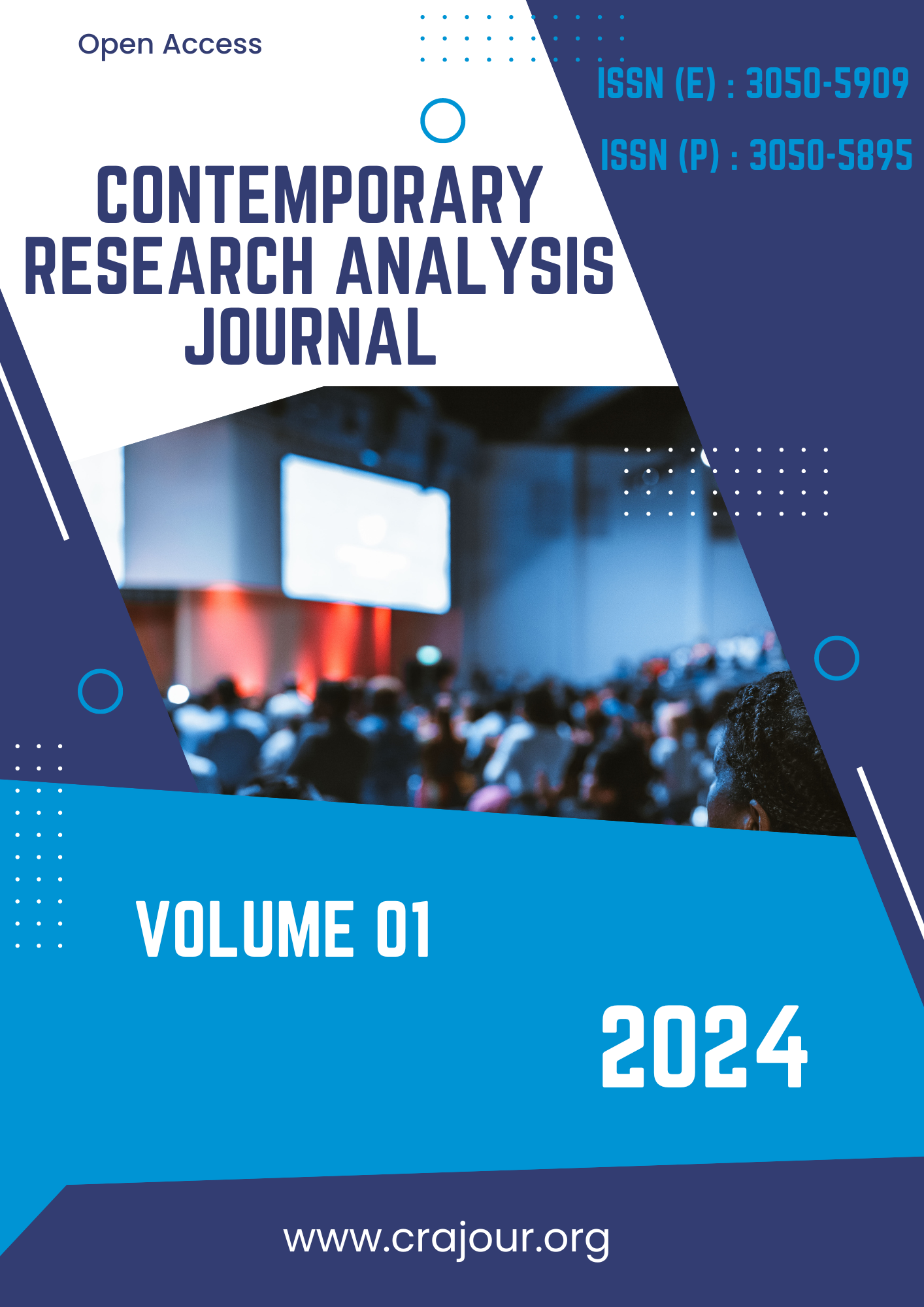Disaster Risk Reduction Measures and Disaster Preparedness of Elementary Schools in Babak District
DOI:
https://doi.org/10.55677/CRAJ/04-2024-Vol01I4Keywords:
Disaster Risk Reduction Measures, Disaster Preparedness, Teachers and StudentsAbstract
The study determines the level of disaster risk reduction measures (DRRM) and disaster preparedness, as well as the significant relationship between the two variables in Cogon, San Antonio, and Toril elementary schools in Babak District. A descriptive-correlational research design was employed in this study. Data analysis involved the use of the weighted average mean and the Pearson Product- Moment Correlation Coefficient. A total of forty-five school heads and teachers respondents were selected through total population sampling. The findings of the study revealed that the levels of disaster risk reduction measures (DRRM) and disaster preparedness in the selected schools are very high, suggesting successful integration and implementation of DRRM strategies. Additionally, a significant relationship was found between the two variables, indicating that increased implementation of disaster risk reduction measures (DRRM) corresponds to higher levels of disaster preparedness in the schools. Consequently, incorporating DRRM into school systems improves the readiness of school heads and teachers for unexpected disasters. The school heads and teachers possess more knowledge and skills to handle disasters, as they are responsible for guiding and protecting students during such events.
References
Abenoja, S., W. Baog, I., C. Briz, A., Mae M. Bustamante, H., Garcia, R., Mongado, R., & Joy B. Ramos, A. (2023). The Implementation Level of Disaster Risk Reduction Management and Disaster Preparedness in Selected Schools in Davao de Oro. International Journal of Research Publications.
Acierto, C. P., Robas, J. M., & Monte, S. D. (2023). Extent of Disaster Risk Reduction Management in Selected Elementary Schools: Evidence from the Philippines. International Review of Social Sciences Research, 3(2), 1–
19. https://doi.org/10.53378/352981
Amidei, J., Piwek, P., & Willis, A. (2019). The use of rating and Likert scales in Natural Language Generation human evaluation tasks: A review and some recommendations.
Andriesse E., (2018). Primary sector value chains, poverty reduction, and rural development challenges in the Philippines. Geogr Rev 108:345–366. https://doi.org/10.1111/gere.12287
Bastami, M., Abbasnejadfard, M., Motamed, H., Ansari, A., & Garakaninezhad, A. (2022). Development of hybrid earthquake vulnerability functions for typical residential buildings in Iran. International Journal of Disaster Risk Reduction, 77, 103087.
Bello T. B., Bamigbayan I. O., Adeyemi, M. A., Odekuoye, J. O., & Ajayi, E. A. (2022). Disaster preparedness level in hazard laden environment: A case study of tertiary institution students in Osogbo, Osun State, Nigeria. Research Journal of Health Sciences, 10(4), 390-400.
Bentillo, E. V., Cavan, C. T., Lacara, C. M. C., MarieMosqueda, A., Buala, M. A., Suson, R., ... & Yabo, R. (2022). ASSURING PROMPT AND APPROPRIATE MITIGATING MEASURES FOR DISASTER RISK REDUCTION PROGRAMS IN BASIC EDUCATION.
Bhat, A. (2023). Descriptive Correlational: Descriptive vs correlational research. QuestionPro. Retrieved from https://www.questionpro.com/blog/descriptive-research-vs-correlational-research/#:~:text=Descriptive%20correlational%20research%20is%20a% 20type%20of%20research,see%20if%20there%20is%20a%20link%20bet ween%20them.
Bronfman, N. C., Cisternas, P. C., Repetto, P. B., & Castañeda, J. V. (2019). Natural disaster preparedness in a multi-hazard environment: Characterizing the sociodemographic profile of those better (worse) prepared. PloS one, 14(4), e0214249.
Canales, R. O., & Sanico, F. L. (2021). Survey on disaster risk reduction measures in the Balicuatro area schools of northern Samar. Asian Journal of Advanced Research and Reports, 64–74. https://doi.org/10.9734/ajarr/2021/v15i230368
Canonizado, I. C. (2020). When to Use Total Population Sampling in a Research Study.
Dela Cruz, D. & Ormilla, R. C. G. (2022). Disaster Risk Reduction Management Implementation in the Public Elementary Schools of the Department of Education, Philippines. International Journal of Disaster Risk Management, 4(2), 1-15. https://doi.org/10.18485/ijdrm.2022.4.2.1
Fraenkel, J. R. & Wallen, N. E. (2009). How to Design and Evaluate Research in Education Seventh Edition. New York: McGraw-Hill.
Herdiansyah, H., Husein, S. I., Asrofani, F. W., & Kholila, B. N. (2020, June). Disaster awareness through disaster preparedness education for primary schools. In IOP Conference Series: Earth and Environmental Science (Vol. 519, No. 1, p. 012016). IOP Publishing.
International Research Institute of Disaster Science (2015). The Sendai Declaration, adopted at the international forum for promoting education on Disaster Resilience: Development of a Resilient Community and Improving Disaster Education and Regional Disaster Preparedness", was held on March 14, 2015, at Tohoku University, Sendai City, Japan. (http://drredu- collabo.sakura.ne.jp/cms/wp- content/uploads/20151101-3_en.pdf)
Kawasaki, H., Yamasaki, S., Kurokawa, M., Tamura, H., & Sonai, K. (2022). Relationship between teachers' awareness of disaster prevention and concerns about disaster preparedness. Sustainability, 14(13), 8211. doi:https://doi.org/10.3390/su14138211
Kaya, S. (2021). The Factors Predicting Students' Participation in Online English Courses. Eurasian Journal of Educational Research, 91, 301-320.
Kerjan Michel, E., Hochrainer-Stigler, S., Kunreuther, H., Linnerooth-Bayer, J., Mechler, R., Muir-Wood, R., … Young, M. (2012). Catastrophe Risk Models for Evaluating Disaster Risk Reduction Investments in Developing Countries.Risk Analysis, 33(6),984–999.doi:10.1111/j.1539-6924.2012.01928
Kermanshachi, S., Berstrand, K., & Rouhanizadeh, B. (2019). Identifying, weighting and causality modeling of social and economic barriers to rapid infrastructure recovery from natural disasters: A study of hurricanes Harvey, Irma and Maria. Washington, DC: Transportaiton Research Board
Kruger, J., Brener, N., Leeb, R., Wolkin, A., Avchen, R. N., & Dziuban, E. (2018). School district crisis preparedness, response, and recovery plans-United States, 2006, 2012 and 2016. Morbidity and Mortality Weekly Report, 67(30), 809.
Laude, H. F. J. M. J. U. J. (2019). Forty schools were damaged in the Mindanao quake. Philstar.com. https://www.philstar.com/headlines/2019/10/19/1961527/40-schools- damaged-mindanao-quake
Lindell, M. K., & Perry, R. W. (2012). The protective action decision model: theoretical modifications and additional evidence. Risk Analysis, 32(4), 616-632. Web.
Mulilis, J.P., & Duval, T.S. (1998). PrE (Person-Relative-to-Event) Theory of Coping with Threat.
Nipa, T. J., Kermanshachi, S., Patel, R., & Tafazzoli, M. (2020, September). Disaster preparedness education: Construction curriculum requirements to increase students' preparedness in pre-and post-disaster activities. In Associated Schools of Construction (ASC) International Conference (pp. 142-131).
Nuryana Mu’man, Erwinsyah, R. G., & Suradi, S. (2023). Strengthening society preparedness as a strategy for disaster risk reduction in indonesia. IOP Conference Series.Earth and Environmental Science, 1180(1), 012045. doi:https://doi.org/10.1088/1755-1315/1180/1/012045
Ozmen, F. (2006). The level of preparedness of the schools for disasters from the aspect of the school principals. Disaster Prevention and Management, 15(3),383-395. doi:https://doi.org/10.1108/09653560610669873
Pambudi, D. I., & Ashari, A. (2019). Enhancing role of elementary school in developing sustainable disaster preparedness: A review with some examples from disaster-prone areas of merapi. IOP Conference Series.Earth and Environmental Science, 271(1) doi:https://doi.org/10.1088/1755-1315/271/1/012016
Putra, M. I. Rwi. (2017). A CORRELATIONAL STUDYON THEIMPACT OF STUDENTS’ ENGLISH ACHIEVEMENT ON STUDENTS’ RESIDENCE. JET (Journal of English Teaching) Adi Buana, 2(01), 21-35.
Torani, S., et al. 2019. The importance of education on disasters and emergencies: A review article. Journal of Education Health Promotion.Published online 2019 April 24.vol 8: No. 85, tahun 2019. doi:10.4103/jehp.jehp_262_18
Utama, T. A., Delfina, R., & Saleha, N. (2019). PUBLIC PREPAREDNESS FOR FACING EARTHQUAKE DISASTER IN LEMPUING AREA. Jurnal Vokasi Keperawatan (JVK), 2(1), 1–8. https://doi.org/10.33369/jvk.v2i1.9122
Utaya, S., Bachri, S., Isnaeni, N., & Rahman, I. (2023). Disaster Preparedness of Elementary School Principals, Teachers, And Students Based on The Geographical Conditions In Malang District, East Java, Indonesia. Journal of Namibian Studies: History Politics Culture, 35, 1924-1949.
Widowati, E., Istiono, W., & Husodo, A. H. (2021). The development of disaster preparedness and safety school model: A confirmatory factor analysis. International Journal of Disaster Risk Reduction, 53, 102004.
Yadav D.K., & Barve A., (2019). Prioritization of cyclone preparedness activities in humanitarian supply chains using fuzzy analytical network process. Nat Hazards 97:683–7:683-726.https://doi.org/10.1007/s11069-019-03668-3
Downloads
Published
Issue
Section
License
Copyright (c) 2024 Contemporary Research Analysis Journal

This work is licensed under a Creative Commons Attribution 4.0 International License.



